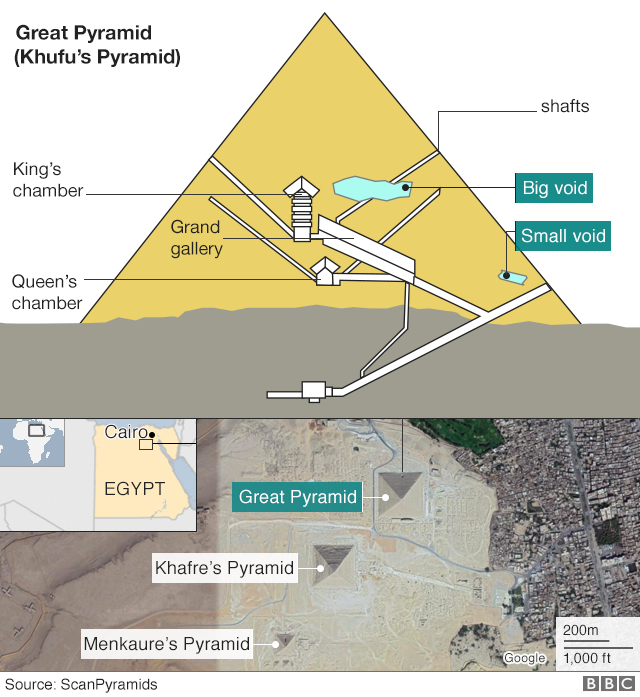The Great Pyramid at Giza has revealed yet another secret. A team of scientists using space-age technology has revealed the presence of a hidden space.
 Pharaoh Khufu's grandest achievement, more than 450 tall, was built more than 4,000 years ago and was sealed until A.D. 820. Those who opened the pyramid found three chambers inside, connected by a large corridor known as the Grand Gallery. The Queen's chamber is at the center of the pyramid; the King's chamber is above that; and another chamber is below the base.
Pharaoh Khufu's grandest achievement, more than 450 tall, was built more than 4,000 years ago and was sealed until A.D. 820. Those who opened the pyramid found three chambers inside, connected by a large corridor known as the Grand Gallery. The Queen's chamber is at the center of the pyramid; the King's chamber is above that; and another chamber is below the base.
Until now, searches for other chambers have proved fruitless. Reliable recordings of construction methods have not survived, nor have building plans.
A team of scientists from Japan's Nagoya University and KEK physics lab have employed a host of new technologies combined with the use of cosmic rays; the result was a previously unknown space, which researchers are not sure is a chamber or a corridor.
The cosmic rays were muons, rays produced in Earth's atmosphere that can penetrate rock. The scientific team collected a monograph, a snapshot of the cosmic ray, along with specialised software and other high-tech collection techniques to take a "picture" of the Great Pyramid's interior. The resulting pattern of solid rock revealed spaces where the known chambers were and also a void previously unknown, directly above the Grand Gallery. The picture is of a low resolution, though, and so scientists still do not have a clear picture of what they have discovered.
The Great Pyramid is protected and sealed, so human intervention isn't a possibility. Other technical investigations in previous years have revealed hints of what might be inside. In 2011, a U.K. researchers sent a snake-like robot into a tunnel inside the Great Pyramid, sending back a few images but not discovering anything new of significance.
The researchers who found the void have concluded that it must have been hidden by the pyramid-builders, heightening speculating that the space might be hiding or protecting something.
It could be another example of something known. The Great Pyramid does contain some small compartments that historians think were incorporated in order to help support the stone and avoid collapse. The newly discovered "void" is larger than those known compartments.
Muography has also been used in recent years to investigate interiors of glaciers and volcanoes and, more famously, the inside of the failed nuclear reactors at Japan's Fukushima Dai-ichi Nuclear Power Plant.